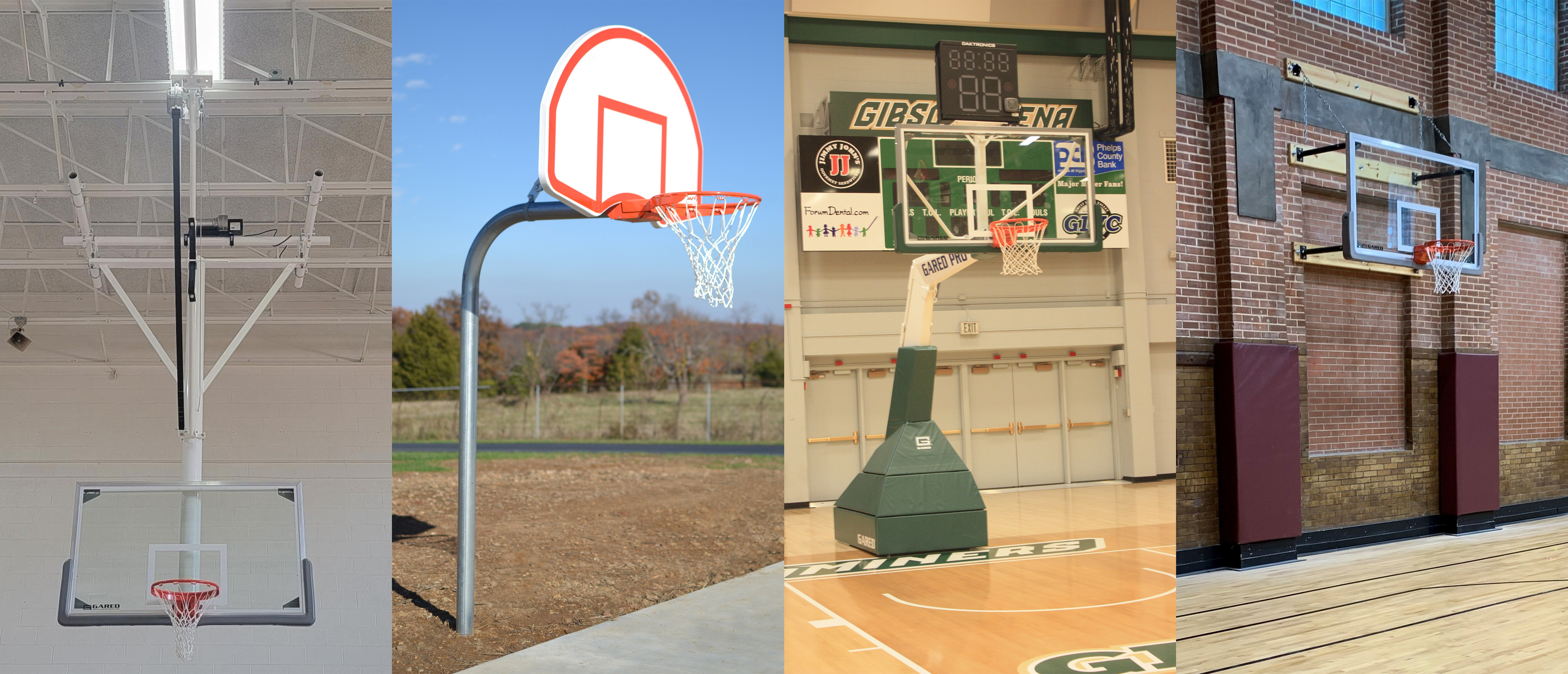When building a basketball court, first you will need to decide on an appropriate backstop. A backstop in basketball terms is defined as anything attached to the back of the backboard and rim to provide support and stability. Consider your play setting, play level, desired features, and budget when choosing your indoor or outdoor basketball backstops.
Wall-Mounted Backstops
Wall-mounted backstops are a popular style for schools, churches, rec centers, and other indoor facilities. This style of backstop is constructed of braced steel pipes in various lengths attached to the wall on one end and the backboard and rim on the other end. Wall mounts are generally available in three designs to fit any facility’s needs. Stationary wall mounts are fixed and do not move into a storage position, while movable styles fold to the wall either up or to the side, making them a great choice for multi-use courts. In addition, wall mounts can be upgraded with convenient options such as electric motors and group controllers to operate folding units and backboard height adjusters to facilitate youth play. Wall mounts are the most cost-effective indoor backstop style, and the buying process is relatively quick and easy because no building information is required prior to purchase.
Ceiling-Hung Backstops
Ceiling-hung backstops are another popular indoor basketball option used in schools, universities, and recreational facilities. This backstop style consists of vertical pipe and bracing attached at the top to a facility’s ceiling, with the backboard and rim attached at the bottom of the pipe. Ceiling units are available in a wide variety of designs, folding styles, and brace positions to accommodate varying building types, ceiling structures, and court spaces. Folding ceiling units are almost always purchased with an electric hoist for convenient operation, allowing multi-sport facilities to maximize their court space by raising the unit up to the ceiling with the flip of a switch. Like wall mounts, these units can be upgraded with options such as group controllers, and backboard height adjusters to facilitate youth play. Because these systems are manufactured and engineered specifically for each facility’s requirements, complete building information is required prior to purchase, which can be a daunting and time-consuming task. In addition, an experienced installer or contractor is required to install the system as well as maintain it regularly to ensure safe operation.
Portable Backstops
Competition portable backstops have been traditionally used for high levels of competition indoor play, such as in high schools, universities, and pro arenas, while smaller portable backstops are popular for youth play, side courts, and recreational use. Portable backstops consist of a completely portable unit with wheels for transport, with either spring-assist or electric operation for lowering into the storage position and raising up into play position. Portable backstops can be upgraded with many options such as automatic wheel lift, shot clock mounts, camera mounts, and boom or base pad graphics. This backstop style is a smart choice for facilities that require many different activities or events to use the same court space; however, a large storage area with an oversized door opening will be needed to house the bulky portable(s) when not in use. In addition, portable backstops are the most expensive style of all the indoor backstops, and the lead time for delivery is generally very long due to the complexities involved in manufacturing the units.
Inground/Surface-Mounted Backstops
Inground and surface-mounted backstops are generally used in outdoor play environments. Inground backstops are installed permanently in a concrete-filled hole in the ground and are commonly used in public outdoor spaces that do not require the systems to be moved. Galvanized steel gooseneck poles or straight posts with adjustable extension arms are the preferred inground backstops for many parks, playgrounds, and outdoor basketball courts because of their durability and longevity. On the other hand, surface-mounted backstops typically have posts that are bolted at the bottom to a plate that’s installed on the playing surface. Surface-mounted backstops are generally sold as a part of residential adjustable basketball systems because they allow the user to unbolt the post from the plate and take it with them if they move. Inground and surface-mounted backstops, when paired with appropriate outdoor backboards and rims, are budget-friendly options for creating long-lasting outdoor courts that will withstand weather elements and heavy play environments.

